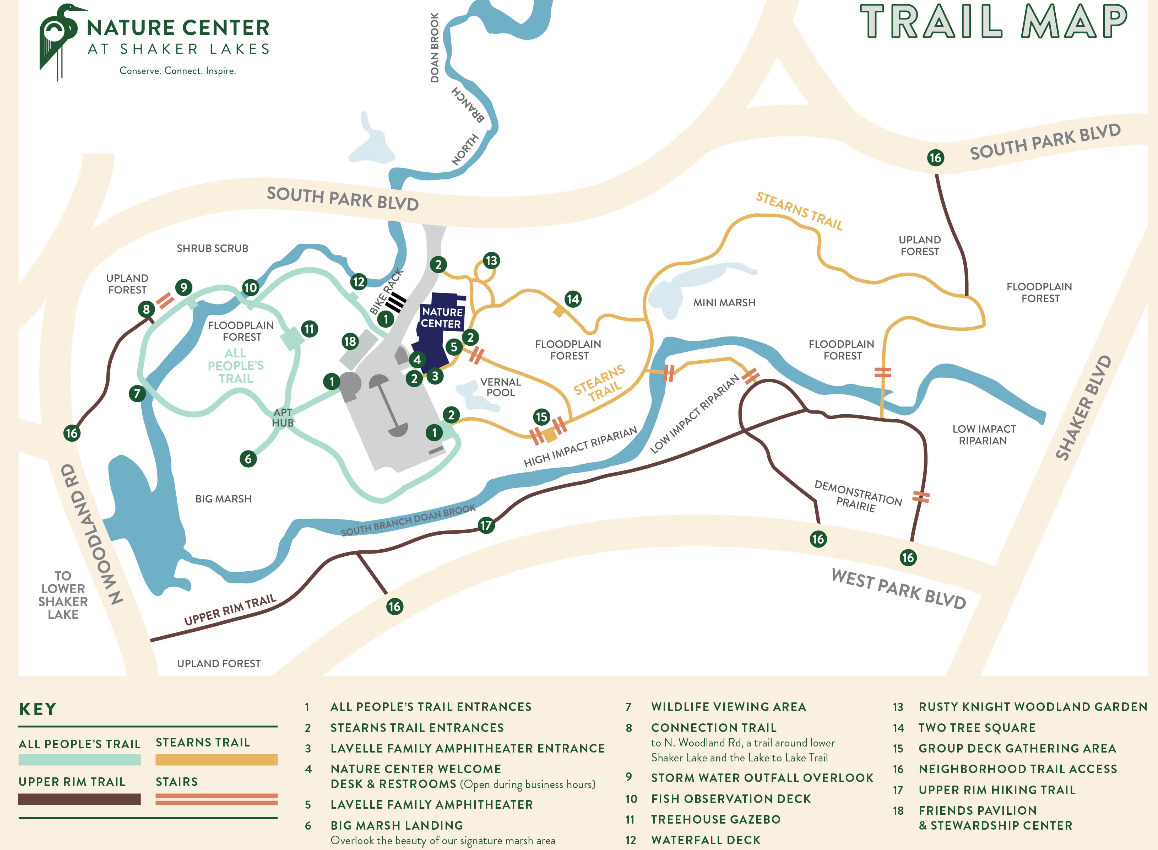Shaker Lakes Park System
Shaker Lakes Park System
South Park Boulevard Shaker Heights, Ohio 44120
Shaker Lakes websiteShaker Lakes Nature Center (Facebook) webpage
History of Shaker Lakes
Shaker Lakes trail information
Shaker Lakes trail map
Also, see all the hotspots at:
Dike 14-Doan Brook Important Bird Area
Tips for Birding
Shaker Lakes Birding Guide (Sameer Apte)
Shaker Lakes is a stop on the Lake Erie Birding Trail.
About Shaker Lakes
See all hotspots at Shaker Lakes
The Nature Center at Shaker Lakes was founded in 1966 as the result of a grassroots community effort to preserve the Shaker Parklands from becoming the route for a new freeway connecting Cleveland’s East Side to downtown.
The parklands had been designated in the late 19th century as a natural green space, set aside by the city of Cleveland for the benefit of its fast-growing population. Citizens used the park as an escape to the “country” as the industrial city pushed eastward and as the land that had been farmed by the North Union Shaker community began to be transformed into the new suburban communities of the Heights. City and suburban residents found that they could enjoy the area along the Doan Brook, from Warrensville Center Road through Rockefeller Park to Lake Erie, and stay in touch with the natural world.
That setting was threatened in the mid-1960s by the proposed Clark-Lee freeway, which would have cut through and over the Shaker Lakes section. Citizens organized to fight the freeway through a number of strategies, including the establishment of a Nature Center. Thus the Nature Center stands today. Its goals have remained consistent, yet simple: to teach environmental education and to preserve the area’s important natural habitats ~ lake, stream, marsh, field, ravine, and forest.
Notable Trails
Shaker Lakes Trails
All Peoples Trail
The award-winning All Peoples Trail is a railed, elevated boardwalk with offers .33 miles of access to nature for people with all physical abilities. It wraps through the forest, over Doan Brook, and overlooks the signature marsh and Lower Shaker Lake. The marsh is a beauty in all seasons but in the height of summer, you will be overwhelmed with the picturesque splendor of the large native blooms. A stepped trail connects the All Peoples Trail to foot and bike trails leading to the Shaker Parklands.
Stearns Trail
This trail is mostly dirt and gravel that begins at the Nature Center’s Rusty Knight Woodland Garden. It can also be accessed by the stairs at the Lavelle Family amphitheater and from the left side of the parking lot. The trail winds through the forest along Doan Brook. Turn or walk among the trees, stop at two-three square, take a rest to look and listen for birds or take the upper rim trail near the Prairie to spot a butterfly. Features along the trail include a marsh observation deck, a brook observation deck, and a brook-side trail.
Upper Rim Trail
Birding is great at Shaker Lakes, stop 23 on the Ohio Lake Erie Birding Trail. It is very accessible all around the two bigger lakes and, though it is in a residential area, there are plenty of very comfortable access points throughout the entire Shaker Lakes Park system. There are also free parking areas. The All People’s Trail (APT) at the Nature Center loops through the marsh and over the wooded Doan Brook. This time of year sparrows are abundant in the newly restored marsh and the woodland understory. During spring and fall migration warblers are plentiful. Lower Lake is accessible via connecting trails from the All People’s Trail at the Nature Center. You can walk around the entire lake with ease and there are trails that weave down along the shore. Sometimes they are muddy and typically more rugged. Road level paths are generally paved. There are no homes on the shore of Lower Lake. The Doan Brook Gorge beyond Lower Lake has dirt paths and there are no homes for the majority of the stretch.
Horseshoe Lake and Southerly Park connect via trails that are accessible from the Stearns Trail, the woodland trail behind the Nature Center. Connecting trails are both footpaths or paved. There are no homes around Horseshoe Lake but there are at Marshall and Green, so access there is more limited.
A description with a map of a hike on the Shaker Lakes trails is on the AllTrails website.
Features
Restrooms on site
Wheelchair accessible trail
Entrance fee
Roadside viewing
Content from Wendy Donkin and Shaker Lakes Park System webpage
